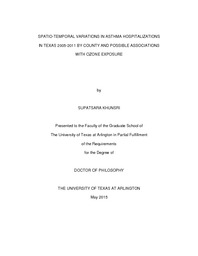
ATTENTION: The works hosted here are being migrated to a new repository that will consolidate resources, improve discoverability, and better show UTA's research impact on the global community. We will update authors as the migration progresses. Please see MavMatrix for more information.
Show simple item record
| dc.contributor.author | Khunsri, Supatsara | en_US |
| dc.date.accessioned | 2015-07-31T22:10:16Z | |
| dc.date.available | 2015-07-31T22:10:16Z | |
| dc.date.submitted | January 2015 | en_US |
| dc.identifier.other | DISS-13145 | en_US |
| dc.identifier.uri | http://hdl.handle.net/10106/25091 | |
| dc.description.abstract | Texas asthma hospitalization data at the county level has been reviewed for the period 2005-2011. Exploratory data analysis revealed a general countywide reduction in the number of hospitalizations over this time period. The data revealed a clear rural county versus urban county disparity in asthma hospitalization rates which were different for both children (< 18 years) and adults (>18 years). County hospitalization rates (per 10,000 Texas residents) used in this study are based exclusively on inpatient hospitalizations. Asthma hospitalization data was provided by the Texas Department of State Health Services. Age-adjusted hospitalization rates revealed that the number of hospitalizations for counties designated as "rural" were consistently greater than for “urban” designated counties among adults and children. The differences between rural and urban hospitalizations were found to be statistically significantly different (p<0.05). Spatial differences across the state were identified with a "hotspot" of higher hospitalization rates for rural and urban counties in south east Texas in the vicinity of Corpus Christi. Counties in this region recorded consistently high hospitalization rates over time. Ozone levels at measurement sites in urban and rural counties in Texas were reviewed for the period 2005-2011. There were almost no statistically significant correlations for most of relationship between ozone exposure and asthma hospitalization rates. Tropospheric ozone formation depends on the ambient levels of pre-cursor gases. Because of the availability of biogenic volatile organic compounds; that are important pre-cursor chemicals, ozone concentrations can be elevated in rural areas. In this study, ozone measurement sites across Texas were categorized as either coastal, intermediate, general urban, or rural. Only one rural site yielded continuous ozone data for the time period of interest, and the data from this site recorded a high percentage of hourly unhealthy air quality events. The coastal sites, some associated with Texas counties reporting high asthma hospitalization rates, recorded a pattern of ozone concentration variations that had peak periods in April/May and September/October in contrast to the general urban sites where the peak in ozone concentrations generally occurred in August/September. | en_US |
| dc.description.sponsorship | Hunt, Andrew | en_US |
| dc.language.iso | en | en_US |
| dc.publisher | Environmental & Earth Science | en_US |
| dc.title | Spatio-temporal Variations In Asthma Hospitalizations In Texas 2005-2011 By County And Possible Association With Ozone Exposure | en_US |
| dc.type | Ph.D. | en_US |
| dc.contributor.committeeChair | Hunt, Andrew | en_US |
| dc.degree.department | Environmental & Earth Science | en_US |
| dc.degree.discipline | Environmental & Earth Science | en_US |
| dc.degree.grantor | University of Texas at Arlington | en_US |
| dc.degree.level | doctoral | en_US |
| dc.degree.name | Ph.D. | en_US |
Files in this item
- Name:
- KHUNSRI_uta_2502D_13145.pdf
- Size:
- 8.528Mb
- Format:
- PDF
This item appears in the following Collection(s)
Show simple item record


